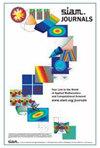随机动态系统的佩伦-弗罗贝尼斯算子滤波器
IF 1.9
3区 工程技术
Q2 MATHEMATICS, INTERDISCIPLINARY APPLICATIONS
引用次数: 0
摘要
SIAM/ASA 不确定性量化期刊》,第 12 卷第 1 期,第 182-211 页,2024 年 3 月。摘要.滤波问题是由代表模型与数据之间折衷的二次函数的连续最小化衍生出来的。本文利用随机过程中的 Perron-Frobenius 算子开发了一种 Perron-Frobenius 算子滤波器。所提出的方法属于贝叶斯滤波法,适用于非线性随机动力系统的非高斯分布。滤波的递归可以用 Perron-Frobenius 算子和似然算子的组成来表征。这给出了佩伦-弗罗贝尼斯算子与贝叶斯滤波之间的重要联系。我们通过乌拉姆法近似 Perron-Frobenius 算子,在数值上实现了递归。这样,Ulam 方法中的指标函数的凸组合就代表了后验度量。为了得到 Perron-Frobenius 算子滤波器的低阶近似值,我们利用离散化 Perron-Frobenius 算子的特征函数对后验量进行谱分解。Perron-Frobenius 算子滤波器利用数据而不是流动方程来模拟底层随机动力系统的演化。相比之下,标准粒子滤波器需要明确的方程或过渡概率密度来进行采样。本文列举了几个数值示例,以说明 Perron-Frobenius 算子滤波器相对于粒子滤波器和扩展卡尔曼滤波器的优势。本文章由计算机程序翻译,如有差异,请以英文原文为准。
Perron–Frobenius Operator Filter for Stochastic Dynamical Systems
SIAM/ASA Journal on Uncertainty Quantification, Volume 12, Issue 1, Page 182-211, March 2024.
Abstract.Filtering problems are derived from a sequential minimization of a quadratic function representing a compromise between the model and data. In this paper, we use the Perron–Frobenius operator in a stochastic process to develop a Perron–Frobenius operator filter. The proposed method belongs to Bayesian filtering and works for non-Gaussian distributions for nonlinear stochastic dynamical systems. The recursion of the filtering can be characterized by the composition of the Perron–Frobenius operator and likelihood operator. This gives a significant connection between the Perron–Frobenius operator and Bayesian filtering. We numerically fulfill the recursion by approximating the Perron–Frobenius operator by Ulam’s method. In this way, the posterior measure is represented by a convex combination of the indicator functions in Ulam’s method. To get a low-rank approximation for the Perron–Frobenius operator filter, we take a spectral decomposition for the posterior measure by using the eigenfunctions of the discretized Perron–Frobenius operator. The Perron–Frobenius operator filter employs data instead of flow equations to model the evolution of underlying stochastic dynamical systems. In contrast, standard particle filters require explicit equations or transition probability density for sampling. A few numerical examples are presented to illustrate the advantage of the Perron–Frobenius operator filter over the particle filter and extended Kalman filter.
Abstract.Filtering problems are derived from a sequential minimization of a quadratic function representing a compromise between the model and data. In this paper, we use the Perron–Frobenius operator in a stochastic process to develop a Perron–Frobenius operator filter. The proposed method belongs to Bayesian filtering and works for non-Gaussian distributions for nonlinear stochastic dynamical systems. The recursion of the filtering can be characterized by the composition of the Perron–Frobenius operator and likelihood operator. This gives a significant connection between the Perron–Frobenius operator and Bayesian filtering. We numerically fulfill the recursion by approximating the Perron–Frobenius operator by Ulam’s method. In this way, the posterior measure is represented by a convex combination of the indicator functions in Ulam’s method. To get a low-rank approximation for the Perron–Frobenius operator filter, we take a spectral decomposition for the posterior measure by using the eigenfunctions of the discretized Perron–Frobenius operator. The Perron–Frobenius operator filter employs data instead of flow equations to model the evolution of underlying stochastic dynamical systems. In contrast, standard particle filters require explicit equations or transition probability density for sampling. A few numerical examples are presented to illustrate the advantage of the Perron–Frobenius operator filter over the particle filter and extended Kalman filter.
求助全文
通过发布文献求助,成功后即可免费获取论文全文。
去求助
来源期刊

Siam-Asa Journal on Uncertainty Quantification
Mathematics-Statistics and Probability
CiteScore
3.70
自引率
0.00%
发文量
51
期刊介绍:
SIAM/ASA Journal on Uncertainty Quantification (JUQ) publishes research articles presenting significant mathematical, statistical, algorithmic, and application advances in uncertainty quantification, defined as the interface of complex modeling of processes and data, especially characterizations of the uncertainties inherent in the use of such models. The journal also focuses on related fields such as sensitivity analysis, model validation, model calibration, data assimilation, and code verification. The journal also solicits papers describing new ideas that could lead to significant progress in methodology for uncertainty quantification as well as review articles on particular aspects. The journal is dedicated to nurturing synergistic interactions between the mathematical, statistical, computational, and applications communities involved in uncertainty quantification and related areas. JUQ is jointly offered by SIAM and the American Statistical Association.
 求助内容:
求助内容: 应助结果提醒方式:
应助结果提醒方式:


